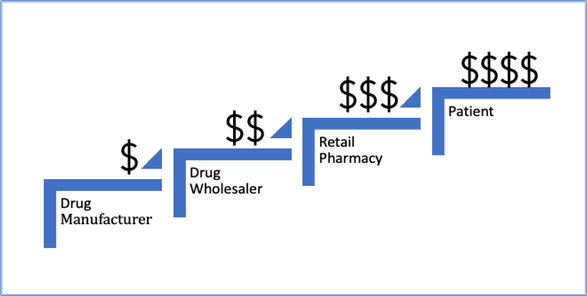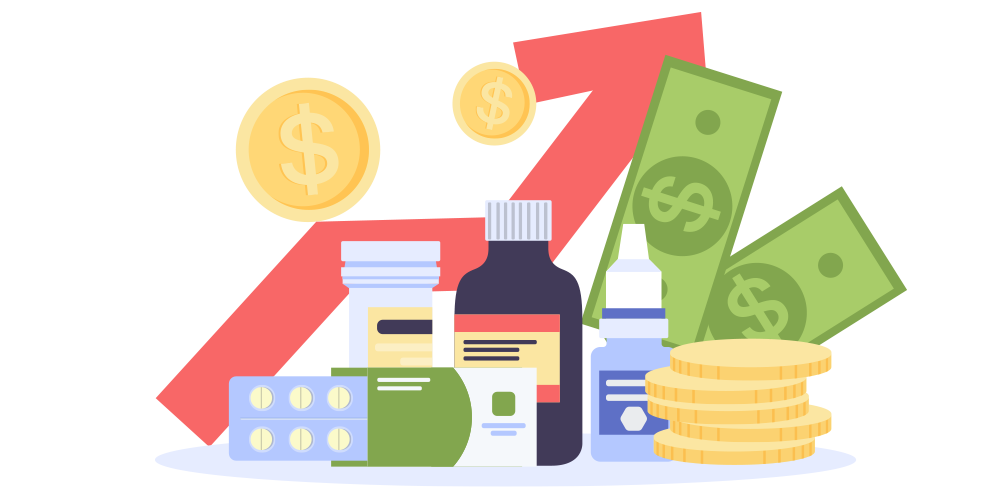Mark Cuban’s eponymous online pharmacy was an interesting new twist in the U.S. drug pricing dilemma this past January. The Cost Plus Drugs Company sells directly to consumers with generic versions of their prescriptions. However, it’s not the first company to do this. DiRx launched the first fully integrated version of this model with a larger portfolio and its own pharmacy infrastructure in the market in the fall of last year to test the model. By sourcing over a thousand prescription generics directly from the manufacturers, and fulfilling and shipping the prescriptions directly to consumers, DiRx found that giving consumers a price closer to the cost of manufacturing was feasible by completely bypassing multiple layers of the distribution chain that added more cost than the product itself.
According to these direct-to-consumer companies, the big reason drug costs are stubbornly high is because of the supply chain. At every stop in the supply chain, a fee is tacked on. In the U.S. there are as many as three layers between the patient and the manufacturer.

DiRx and Cost Plus Drugs work to eliminate the layers between the generic manufacturer and the patient. These companies cover their costs by adding a very nominal margin and provide transparency of pricing to the consumers.
Is it that much cheaper? Apparently. A recent study on Medicare costs with Cost Plus Drugs found that the direct-to-consumer model would have saved Medicare $3.6 billion (37 percent) on 77 of the 89 drugs examined in the study. A review of each company’s website shows a trend towards transparency and accessibility.
Here are a few telling examples from DiRx:
| Generic Name | Brand name | Indication | Monthly Medicare Cost | Monthly DiRx’s Price | Savings to Employer / Health Plan | |
| 1 | Abiraterone Tablets 250mg | Zytiga | Prostate cancer | $3476.40 | $160 | $41,716.80 |
| 2 | Dimethyl Fumarate DR Capsules 120mg | Tecfidera | Multiple Sclerosis | $5162.40 | $900 | $61,948.80 |
| 3 | Imatinib | Gleevec | Leukemia & other cancers | $2502.60 | $60.14 | $30,031.20 |
| 4 | Defarasirox Tabs 180mg | Jadenu | Iron overload | $4120.80 | $97.00 | $49,449.60 |
| 5 | Efavirenz, Emtricitabine & Tenofovir Tablets 600/200/300mg | Atripla | HIV | $2427.30 | $146.47 | $29,127.60 |
Each of the above prescriptions would save a health plan or self-funded employer tens of thousands a year but taken together the total saved would be $212,274 annually – the total cost of the medication. Direct-to-consumer models do not accept insurance, so all prescriptions are “cash-pay”, which essentially removes the cost of the prescription entirely for the employer or plan. The member or employee pays for the medication out of pocket and the insurer never sees it. The out-of-pocket cost is similar or less than the usual co-pay for higher tier drugs.
For consumers, saving money is a no-brainer. Though, one thing that should be taken into consideration when deciding to use a direct-to-consumer company is the deductible. If someone expects to hit their deductible and then get all their prescriptions covered afterward, this model may not be the way to go. The cost of prescriptions with these services does not count towards the deductible. However, the cost of medical services and doctor visits far exceeds the spend on prescription medication for a typical consumer and these costs contribute to the deductible being met faster than prescription drug spend.
DiRx and Cost Plus Drugs are delivering generic prescriptions directly to consumers at a much-reduced price and while both companies continue to add new generics to their inventories – DiRx has 1500+ while Cost Plus Drugs has about 800 – the problem of expensive brand name drugs, biosimilars, and specialty drugs remains.
This is where a drug savings company like RazorMetrics can come in. RazorMetrics’ primary goal is to prompt physicians to prescribe to a client’s well-designed formulary to promote savings for both the plan and its members. The company’s AI technology helps physicians prescribe medications that are covered by their patient’s drug benefit and can track the refill pick-ups. This helps Health Plans and Employers save money on the pharmacy budgets beyond generics but also can provide insight into adherence rates. The process is frictionless for the physician and the patient. To learn more about how RazorMetrics works – schedule a quick call.




